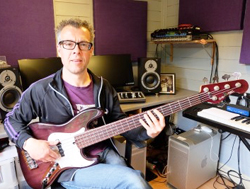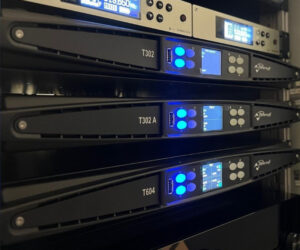An Audient ASP880 and iD22, together with a MacPro, two screens and Dynaudio monitors is all that makes up the studio for bass player Phil Mulford, who’s found himself producing an album with some of his rather famous and talented friends.
His 30-year career encompassing theatre, recording, touring and television – including six series of X-Factor and Britain’s Got Talent – allows Mulford to draw from a deep well of professional experience.
The current album project comprises Jacqui Hicks on vocals (Shakatak), Simon Carter on keyboards (Jamiroquai, Nik Kershaw), Martin ‘Frosty’ Beedle on drums (Cutting Crew, Lifesigns) and Mulford himself on bass.
“We have played together for at least 15 years playing our favourite soul and pop covers,” he says. “I had the great idea of documenting it. It was meant to be a quick snapshot of us but it has taken on a life of its own and we are two years in so far….
“Having the Audient equipment has upped the quality, improving my monitoring and recording path in a big way,” he says, describing his set up as “very simple” and “small, but perfect for tracking.”
“I am using the iD22 as the main interface and the ASP880 as extra inputs. I can have up to 10 inputs for drums or patch keyboards in to arrange or write tunes while I work on my own. The two D.I inputs on the ASP880 are useful along with the impedance switching which is a real bonus.”
He describes how he employs the iD22: “I use outputs 3+4 to send to an outboard Lexicon reverb that works really well and patching and sending to outboard is easy using the iD22 control panel software. I can also set up three different mixes using all three outputs, 1+2, 3+4 and headphones. It means a drummer can have his own mix, I can have a bass mix without affecting the control room mix. These can be saved as setups and recalled from the software. I can also set up sub mixes A+B with zero latency and send these to selected outputs.”
With a launch gig for the album project already in the diary, Mulford has until early July to get it all through the system. “No pressure, then,” he laughs.
Outside of this project, Mulford still does recording sessions – quite a few from home, these days, which he puts down to “smaller budgets and better quality home studios”. He also plays with several visiting American ‘smooth jazz’ artists and is the resident bassist at the world premier production of The Commitments in the west end of London, where he is “…enjoying playing some great soul classics every night.”
Not bad for someone who started a band at 13 with two friends who played drums and guitar, and “…ended up with the bass by default.”
Mulford reckons that keeping it real is the only way to get on in this business. “Having a website and Facebook profile is not going to guarantee you work, so getting out and meeting other musicians is essential. I still go to quite a few gigs and bump into new faces all the time,” he says.
His advice to up-and-coming players? “Target the sort of work you want to do and meet other musicians.”





















